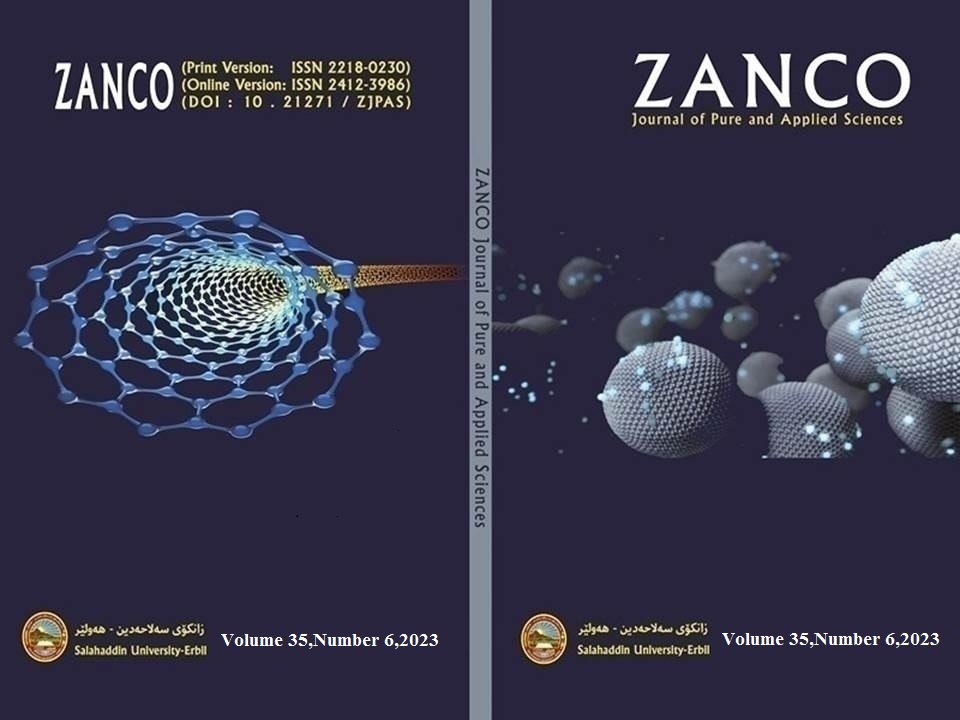Estimation of Flood Hydrograph for Aquban Catchment Area Using Two Models.
DOI:
https://doi.org/10.21271/ZJPAS.35.6.6Keywords:
Flood Hydrograph, GIUH, HEC-1Abstract
The construction of the flood hydrograph in an ungagged catchment area is a challenging portion of the hydrological analysis for design any hydraulic structure. The geomorphologic instantaneous unit hydrograph (GIUH) and Hydrologic Engineers Center (HEC-1) models are widely used for this purpose. The GIUH model simulates flood hydrographs, and the parameters are influenced by the geomorphological features of the area which is based on the probability density function of excess rainfall reaching the catchment. The flood hydrograph is also generated using the HEC-1 model, which is a deterministic hydrological model for simulating rainfall-runoff processes. The nearest station to the Aquban catchment area is Shaqlwa meteorological station that recorded maximum daily rainfall 128.5mm in 2016. The resulting flood hydrographs for the Aquabn catchment area are compared between the GIUH model and the HEC-1 model, with peak discharge and time to peak being the main parameters analyzed. The peak flow of GIUH model is 303.7 m3/s with a time to peak of 1.2 hours, while the HEC-1 model produced a peak discharge of 293.6 m3/s with time to peak of 1.33 hours.
References
BAMUFLEH, S., AL-WAGDANY, A., ELFEKI, A. & CHAABANI, A. 2020. Developing a geomorphological instantaneous unit hydrograph (GIUH) using equivalent Horton-Strahler ratios for flash flood predictions in arid regions. Geomatics, Natural Hazards and Risk, 11, 1697-1723.
CENTER, H. E. & CENTER, W. R. S. 1981. HEC-1 flood hydrograph package: Users manual, US Army Corps of Engineers, Water Resources Support Center, Hydrologic ….
CHOW, V., MAYS, L. & MAIDMENT 1988. Applied Hydrology, New York, McGraw-Hill Professional.
DINGMAN, S. L. 2015. Physical hydrology, Waveland press.
DURU, J. O. & HJELMFELT JR, A. T. 1994. Investigating prediction capability of HEC-1 and KINEROS kinematic wave runoff models. Journal of Hydrology, 157, 87-103.
ELLOUZE-GARGOURI, E. & BARGAOUI, Z. 2012. Runoff estimation for an ungauged catchment using geomorphological instantaneous unit hydrograph (GIUH) and copulas. Water resources management, 26, 1615-1638.
GEHBREHIWOT, A. & KOZLOV, D. GIUH-Nash based runoff prediction for Debarwa catchment in Eritrea. E3S Web of Conferences, 2019. EDP Sciences, 05001.
HIMANSHU, S. K., PANDEY, A. & PALMATE, S. S. Derivation of Nash model parameters from geomorphological instantaneous unit hydrograph for a Himalayan river using ASTER DEM. Proceedings of international conference on structural architectural and civil engineering, Dubai, 2015.
HORTON, R. E. 1945. Erosional development of streams and their drainage basins; hydrophysical approach to quantitative morphology. Geological society of America bulletin, 56, 275-370.
HYDROLOGIC-ENGINEERING-CENTER 1981. HEC-1 flood hydrograph package: Users manual, US Army Corps of Engineers, Water Resources Support Center, Hydrologic Engineering Center.
KUMAR, R., CHATTERJEE, C., SINGH, R., LOHANI, A. & KUMAR, S. 2007. Runoff estimation for an ungauged catchment using geomorphological instantaneous unit hydrograph (GIUH) models. Hydrological Processes: An International Journal, 21, 1829-1840.
MISHRA, S. K. & SINGH, V. 2003. Soil conservation service curve number (SCS-CN) methodology, Springer Science & Business Media.
NASH, J. 1957. The form of the instantaneous unit hydrograph. Comptes Rendus et Rapports Assemblee Generale de Toronto, 3, 114-121.
RODRÍGUEZ‐ITURBE, I. & VALDÉS, J. B. 1979. The geomorphologic structure of hydrologic response. Water resources research, 15, 1409-1420.
ROSSO, R. 1984. Nash model relation to Horton order ratios. Water Resources Research, 20, 914-920.
SINGH, K. & SARKAR, S. 2013. Development of GIUH for the catchment contributing to Loktak Lake, North East India. Journal of the Indian Society of Remote Sensing, 41, 447-459.
SINGH, S. K. 2004. Simplified use of gamma-distribution/Nash model for runoff modeling. Journal of Hydrologic Engineering, 9, 240-243.
SIVAPALAN, M., TAKEUCHI, K., FRANKS, S., GUPTA, V., KARAMBIRI, H., LAKSHMI, V., LIANG, X., MCDONNELL, J., MENDIONDO, E. & O'CONNELL, P. 2003. IAHS Decade on Predictions in Ungauged Basins (PUB), 2003–2012: Shaping an exciting future for the hydrological sciences. Hydrological sciences journal, 48, 857-880.
SUBRAMANYA, K. 2015. Engineering Hydrology, ; 8th reprint. McGraw Hill Education: Noida, India.
SUI, J. 2005. Estimation of design flood hydrograph for an ungauged watershed. Water resources management, 19, 813-830.
USDA, N. R. C. S. 2004. National Engineering Handbook—Part Chapter 9: Hydrologic Soil Cover Complexes. USDA Natural Resource Conservation Service Washington, DC, USA.
VIMAL, S., KUMAR, D. N. & JAYA, I. Extraction of drainage pattern from aster and srtm data for a river basin using gis tools. International Conference on Environment, Energy and Biotechnology, 2012. 120-129.
Downloads
Published
How to Cite
Issue
Section
License
Copyright (c) 2023 Sarkawt Hamarahim Muhammad , Abdulla A. Abo , Yaseen Wsu Azeez

This work is licensed under a Creative Commons Attribution 4.0 International License.














